Market Franchise Report: Analyzing Market Laws and Franchise Rights
VerifiedAdded on 2023/06/10
|7
|2096
|130
Report
AI Summary
This report provides a detailed analysis of market franchise laws, focusing on the legal aspects of establishing and operating a market. It begins by defining a market and outlining the features of a legal market, emphasizing the importance of legal considerations in business. The report then delves into the legal provisions required for establishing a market, including market rights, authorization from local authorities, and regulations concerning street trading. It explains how the market in question was established, highlighting compliance with legal requirements. The report also presents tests to identify rival markets, such as analyzing advertisements, gathering information from customers, and organizing trade exhibitions. Furthermore, it discusses market franchise rights, including protection from interference and the common law distance of 6 2/3 miles. The report concludes with recommendations on the course of action to protect market franchise rights, suggesting reporting the matter to local authorities to prevent the establishment of a rival market within the protected distance.
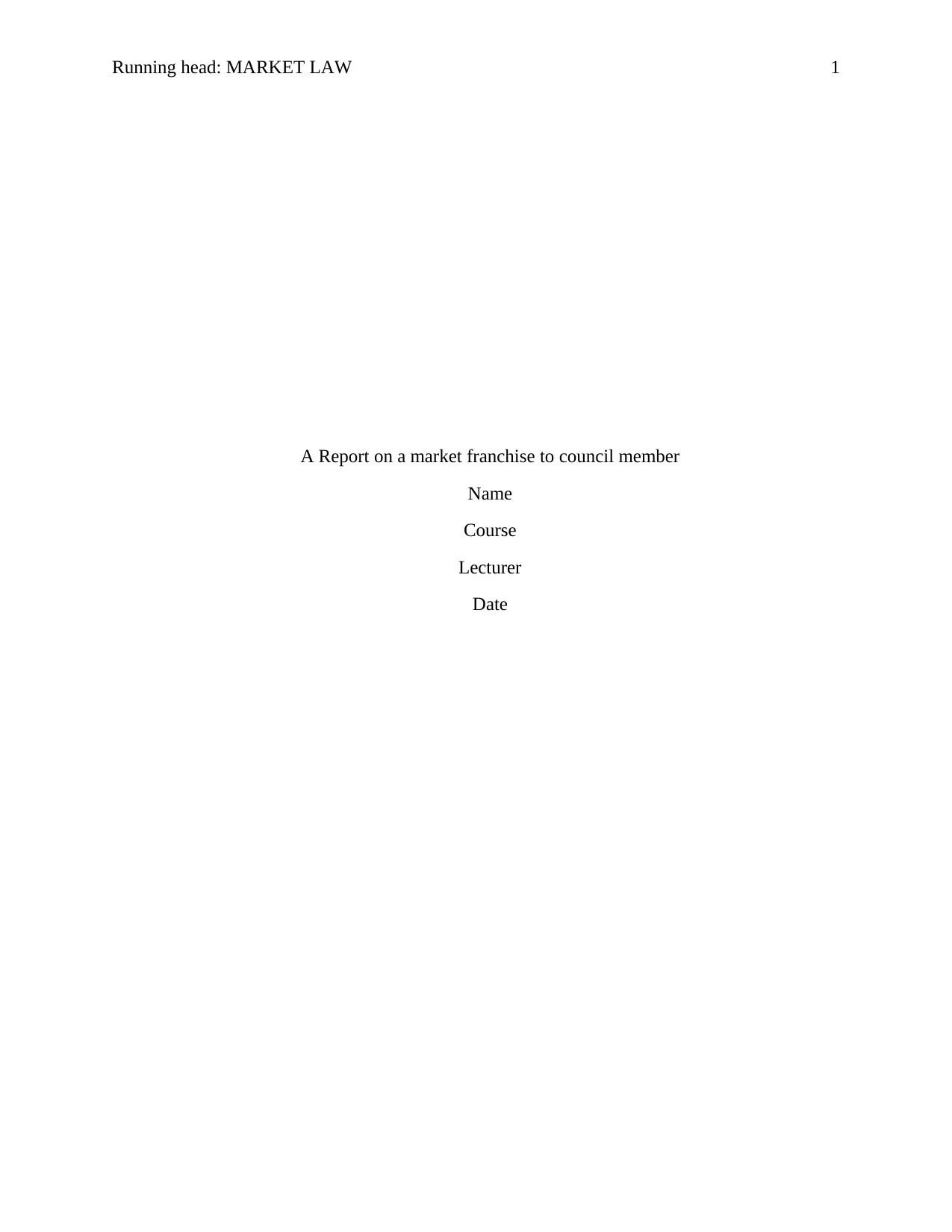
Running head: MARKET LAW 1
A Report on a market franchise to council member
Name
Course
Lecturer
Date
A Report on a market franchise to council member
Name
Course
Lecturer
Date
Paraphrase This Document
Need a fresh take? Get an instant paraphrase of this document with our AI Paraphraser
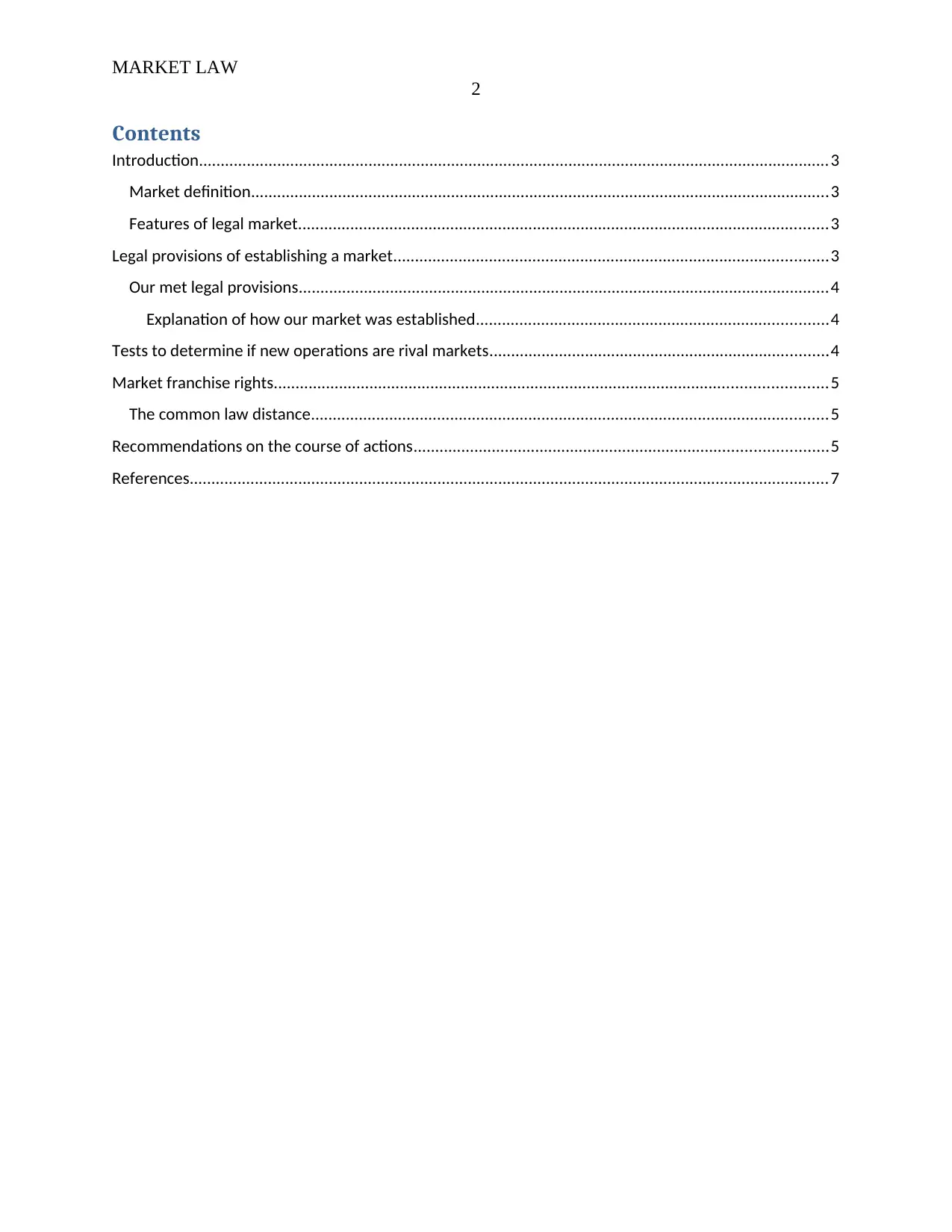
MARKET LAW
2
Contents
Introduction.................................................................................................................................................3
Market definition.....................................................................................................................................3
Features of legal market..........................................................................................................................3
Legal provisions of establishing a market....................................................................................................3
Our met legal provisions..........................................................................................................................4
Explanation of how our market was established.................................................................................4
Tests to determine if new operations are rival markets..............................................................................4
Market franchise rights...............................................................................................................................5
The common law distance.......................................................................................................................5
Recommendations on the course of actions...............................................................................................5
References...................................................................................................................................................7
2
Contents
Introduction.................................................................................................................................................3
Market definition.....................................................................................................................................3
Features of legal market..........................................................................................................................3
Legal provisions of establishing a market....................................................................................................3
Our met legal provisions..........................................................................................................................4
Explanation of how our market was established.................................................................................4
Tests to determine if new operations are rival markets..............................................................................4
Market franchise rights...............................................................................................................................5
The common law distance.......................................................................................................................5
Recommendations on the course of actions...............................................................................................5
References...................................................................................................................................................7
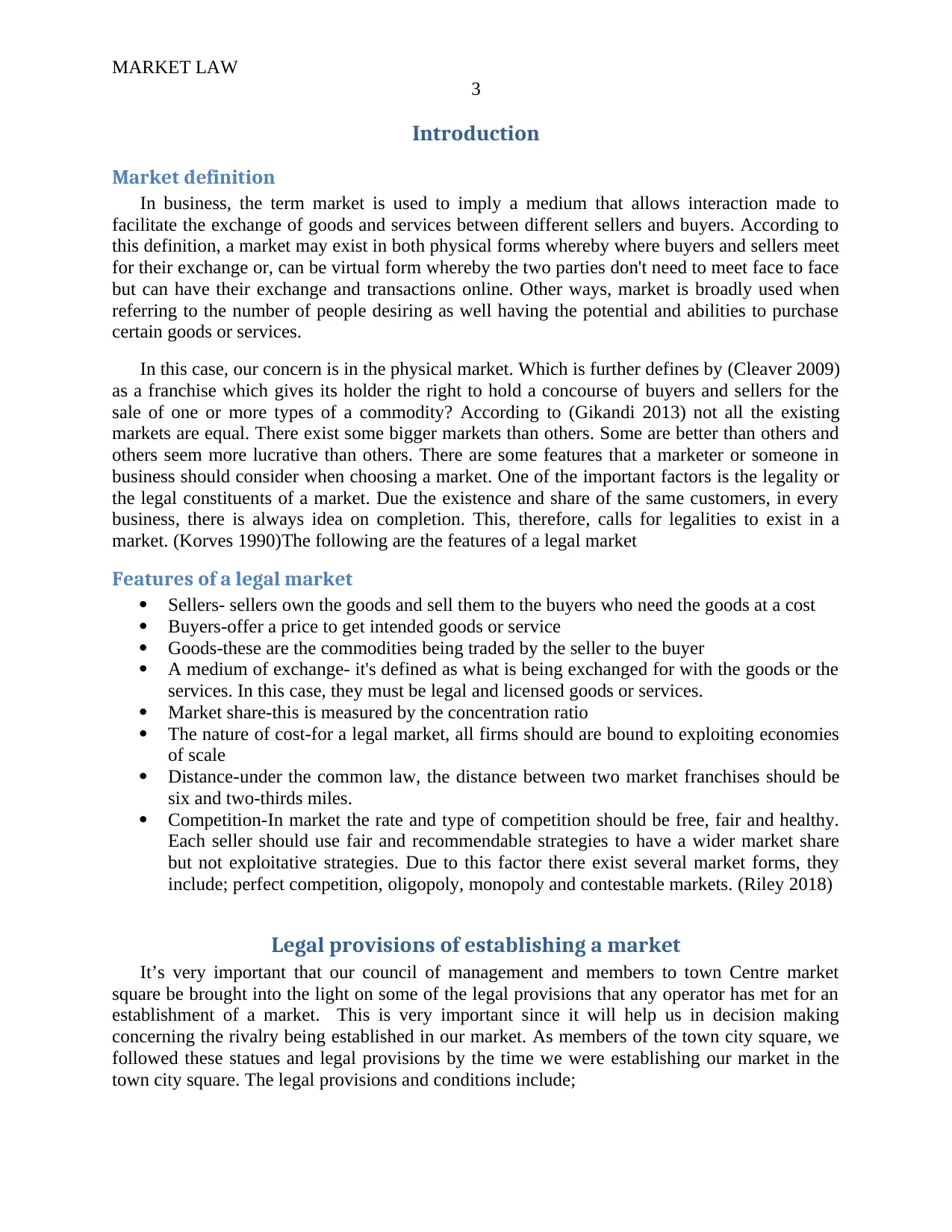
MARKET LAW
3
Introduction
Market definition
In business, the term market is used to imply a medium that allows interaction made to
facilitate the exchange of goods and services between different sellers and buyers. According to
this definition, a market may exist in both physical forms whereby where buyers and sellers meet
for their exchange or, can be virtual form whereby the two parties don't need to meet face to face
but can have their exchange and transactions online. Other ways, market is broadly used when
referring to the number of people desiring as well having the potential and abilities to purchase
certain goods or services.
In this case, our concern is in the physical market. Which is further defines by (Cleaver 2009)
as a franchise which gives its holder the right to hold a concourse of buyers and sellers for the
sale of one or more types of a commodity? According to (Gikandi 2013) not all the existing
markets are equal. There exist some bigger markets than others. Some are better than others and
others seem more lucrative than others. There are some features that a marketer or someone in
business should consider when choosing a market. One of the important factors is the legality or
the legal constituents of a market. Due the existence and share of the same customers, in every
business, there is always idea on completion. This, therefore, calls for legalities to exist in a
market. (Korves 1990)The following are the features of a legal market
Features of a legal market
Sellers- sellers own the goods and sell them to the buyers who need the goods at a cost
Buyers-offer a price to get intended goods or service
Goods-these are the commodities being traded by the seller to the buyer
A medium of exchange- it's defined as what is being exchanged for with the goods or the
services. In this case, they must be legal and licensed goods or services.
Market share-this is measured by the concentration ratio
The nature of cost-for a legal market, all firms should are bound to exploiting economies
of scale
Distance-under the common law, the distance between two market franchises should be
six and two-thirds miles.
Competition-In market the rate and type of competition should be free, fair and healthy.
Each seller should use fair and recommendable strategies to have a wider market share
but not exploitative strategies. Due to this factor there exist several market forms, they
include; perfect competition, oligopoly, monopoly and contestable markets. (Riley 2018)
Legal provisions of establishing a market
It’s very important that our council of management and members to town Centre market
square be brought into the light on some of the legal provisions that any operator has met for an
establishment of a market. This is very important since it will help us in decision making
concerning the rivalry being established in our market. As members of the town city square, we
followed these statues and legal provisions by the time we were establishing our market in the
town city square. The legal provisions and conditions include;
3
Introduction
Market definition
In business, the term market is used to imply a medium that allows interaction made to
facilitate the exchange of goods and services between different sellers and buyers. According to
this definition, a market may exist in both physical forms whereby where buyers and sellers meet
for their exchange or, can be virtual form whereby the two parties don't need to meet face to face
but can have their exchange and transactions online. Other ways, market is broadly used when
referring to the number of people desiring as well having the potential and abilities to purchase
certain goods or services.
In this case, our concern is in the physical market. Which is further defines by (Cleaver 2009)
as a franchise which gives its holder the right to hold a concourse of buyers and sellers for the
sale of one or more types of a commodity? According to (Gikandi 2013) not all the existing
markets are equal. There exist some bigger markets than others. Some are better than others and
others seem more lucrative than others. There are some features that a marketer or someone in
business should consider when choosing a market. One of the important factors is the legality or
the legal constituents of a market. Due the existence and share of the same customers, in every
business, there is always idea on completion. This, therefore, calls for legalities to exist in a
market. (Korves 1990)The following are the features of a legal market
Features of a legal market
Sellers- sellers own the goods and sell them to the buyers who need the goods at a cost
Buyers-offer a price to get intended goods or service
Goods-these are the commodities being traded by the seller to the buyer
A medium of exchange- it's defined as what is being exchanged for with the goods or the
services. In this case, they must be legal and licensed goods or services.
Market share-this is measured by the concentration ratio
The nature of cost-for a legal market, all firms should are bound to exploiting economies
of scale
Distance-under the common law, the distance between two market franchises should be
six and two-thirds miles.
Competition-In market the rate and type of competition should be free, fair and healthy.
Each seller should use fair and recommendable strategies to have a wider market share
but not exploitative strategies. Due to this factor there exist several market forms, they
include; perfect competition, oligopoly, monopoly and contestable markets. (Riley 2018)
Legal provisions of establishing a market
It’s very important that our council of management and members to town Centre market
square be brought into the light on some of the legal provisions that any operator has met for an
establishment of a market. This is very important since it will help us in decision making
concerning the rivalry being established in our market. As members of the town city square, we
followed these statues and legal provisions by the time we were establishing our market in the
town city square. The legal provisions and conditions include;
⊘ This is a preview!⊘
Do you want full access?
Subscribe today to unlock all pages.

Trusted by 1+ million students worldwide
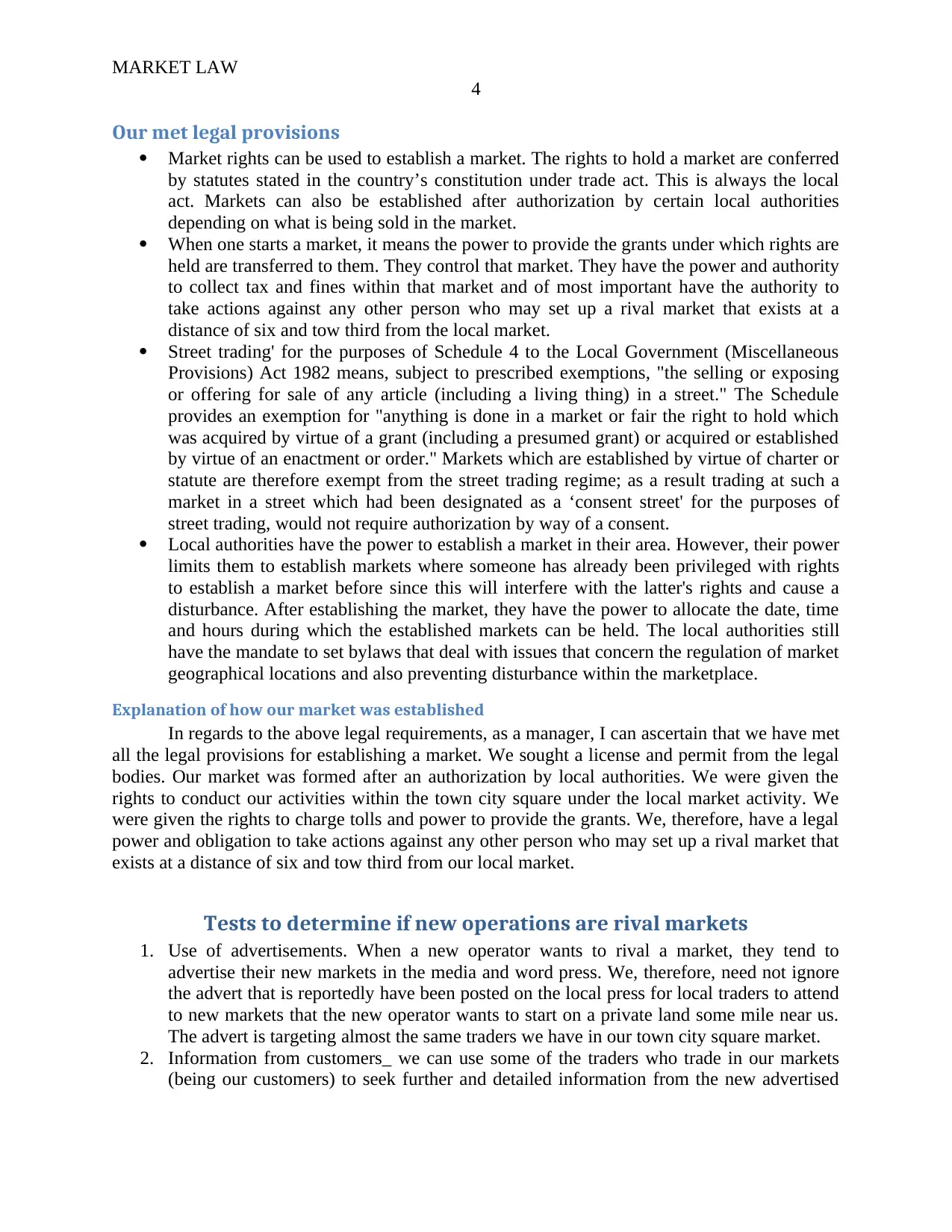
MARKET LAW
4
Our met legal provisions
Market rights can be used to establish a market. The rights to hold a market are conferred
by statutes stated in the country’s constitution under trade act. This is always the local
act. Markets can also be established after authorization by certain local authorities
depending on what is being sold in the market.
When one starts a market, it means the power to provide the grants under which rights are
held are transferred to them. They control that market. They have the power and authority
to collect tax and fines within that market and of most important have the authority to
take actions against any other person who may set up a rival market that exists at a
distance of six and tow third from the local market.
Street trading' for the purposes of Schedule 4 to the Local Government (Miscellaneous
Provisions) Act 1982 means, subject to prescribed exemptions, "the selling or exposing
or offering for sale of any article (including a living thing) in a street." The Schedule
provides an exemption for "anything is done in a market or fair the right to hold which
was acquired by virtue of a grant (including a presumed grant) or acquired or established
by virtue of an enactment or order." Markets which are established by virtue of charter or
statute are therefore exempt from the street trading regime; as a result trading at such a
market in a street which had been designated as a ‘consent street' for the purposes of
street trading, would not require authorization by way of a consent.
Local authorities have the power to establish a market in their area. However, their power
limits them to establish markets where someone has already been privileged with rights
to establish a market before since this will interfere with the latter's rights and cause a
disturbance. After establishing the market, they have the power to allocate the date, time
and hours during which the established markets can be held. The local authorities still
have the mandate to set bylaws that deal with issues that concern the regulation of market
geographical locations and also preventing disturbance within the marketplace.
Explanation of how our market was established
In regards to the above legal requirements, as a manager, I can ascertain that we have met
all the legal provisions for establishing a market. We sought a license and permit from the legal
bodies. Our market was formed after an authorization by local authorities. We were given the
rights to conduct our activities within the town city square under the local market activity. We
were given the rights to charge tolls and power to provide the grants. We, therefore, have a legal
power and obligation to take actions against any other person who may set up a rival market that
exists at a distance of six and tow third from our local market.
Tests to determine if new operations are rival markets
1. Use of advertisements. When a new operator wants to rival a market, they tend to
advertise their new markets in the media and word press. We, therefore, need not ignore
the advert that is reportedly have been posted on the local press for local traders to attend
to new markets that the new operator wants to start on a private land some mile near us.
The advert is targeting almost the same traders we have in our town city square market.
2. Information from customers_ we can use some of the traders who trade in our markets
(being our customers) to seek further and detailed information from the new advertised
4
Our met legal provisions
Market rights can be used to establish a market. The rights to hold a market are conferred
by statutes stated in the country’s constitution under trade act. This is always the local
act. Markets can also be established after authorization by certain local authorities
depending on what is being sold in the market.
When one starts a market, it means the power to provide the grants under which rights are
held are transferred to them. They control that market. They have the power and authority
to collect tax and fines within that market and of most important have the authority to
take actions against any other person who may set up a rival market that exists at a
distance of six and tow third from the local market.
Street trading' for the purposes of Schedule 4 to the Local Government (Miscellaneous
Provisions) Act 1982 means, subject to prescribed exemptions, "the selling or exposing
or offering for sale of any article (including a living thing) in a street." The Schedule
provides an exemption for "anything is done in a market or fair the right to hold which
was acquired by virtue of a grant (including a presumed grant) or acquired or established
by virtue of an enactment or order." Markets which are established by virtue of charter or
statute are therefore exempt from the street trading regime; as a result trading at such a
market in a street which had been designated as a ‘consent street' for the purposes of
street trading, would not require authorization by way of a consent.
Local authorities have the power to establish a market in their area. However, their power
limits them to establish markets where someone has already been privileged with rights
to establish a market before since this will interfere with the latter's rights and cause a
disturbance. After establishing the market, they have the power to allocate the date, time
and hours during which the established markets can be held. The local authorities still
have the mandate to set bylaws that deal with issues that concern the regulation of market
geographical locations and also preventing disturbance within the marketplace.
Explanation of how our market was established
In regards to the above legal requirements, as a manager, I can ascertain that we have met
all the legal provisions for establishing a market. We sought a license and permit from the legal
bodies. Our market was formed after an authorization by local authorities. We were given the
rights to conduct our activities within the town city square under the local market activity. We
were given the rights to charge tolls and power to provide the grants. We, therefore, have a legal
power and obligation to take actions against any other person who may set up a rival market that
exists at a distance of six and tow third from our local market.
Tests to determine if new operations are rival markets
1. Use of advertisements. When a new operator wants to rival a market, they tend to
advertise their new markets in the media and word press. We, therefore, need not ignore
the advert that is reportedly have been posted on the local press for local traders to attend
to new markets that the new operator wants to start on a private land some mile near us.
The advert is targeting almost the same traders we have in our town city square market.
2. Information from customers_ we can use some of the traders who trade in our markets
(being our customers) to seek further and detailed information from the new advertised
Paraphrase This Document
Need a fresh take? Get an instant paraphrase of this document with our AI Paraphraser
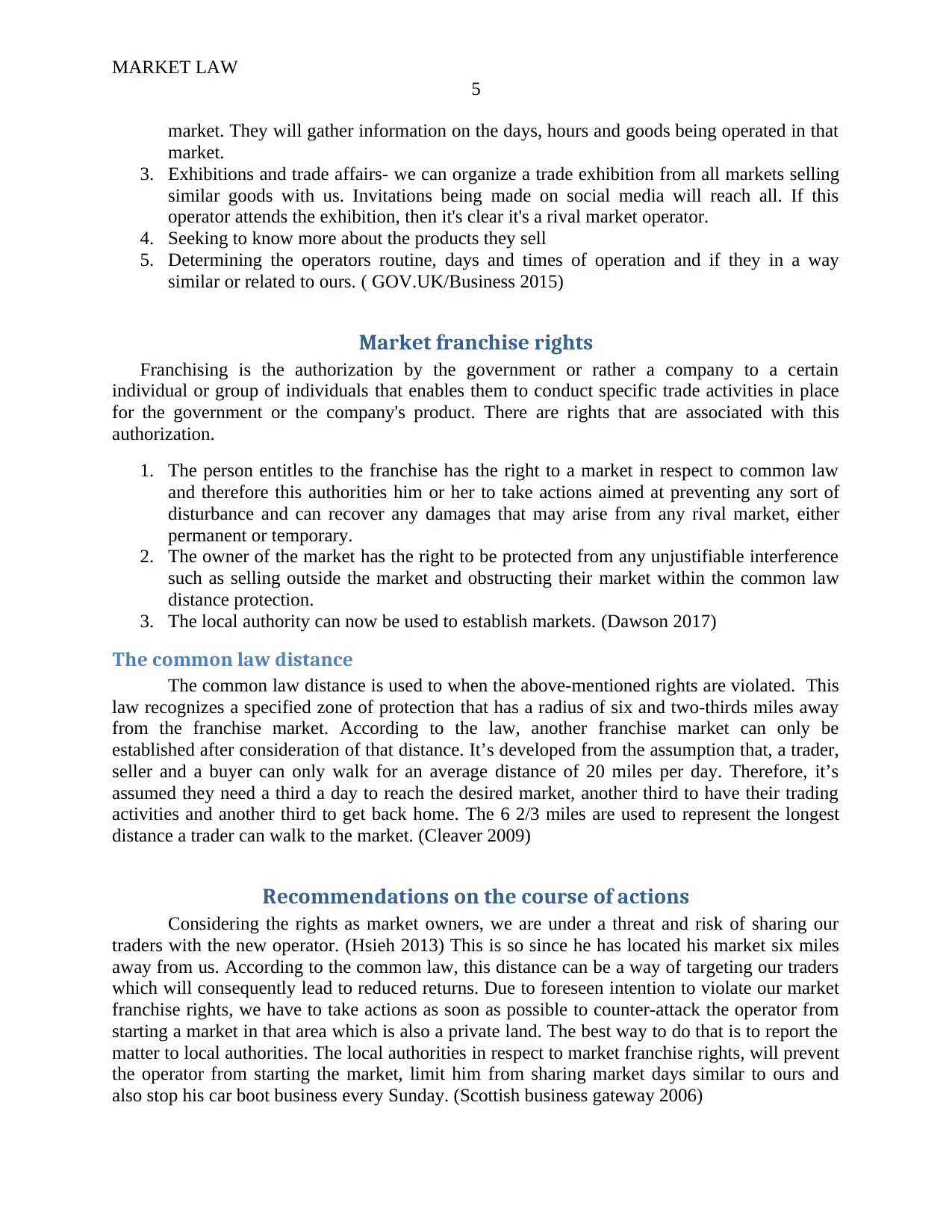
MARKET LAW
5
market. They will gather information on the days, hours and goods being operated in that
market.
3. Exhibitions and trade affairs- we can organize a trade exhibition from all markets selling
similar goods with us. Invitations being made on social media will reach all. If this
operator attends the exhibition, then it's clear it's a rival market operator.
4. Seeking to know more about the products they sell
5. Determining the operators routine, days and times of operation and if they in a way
similar or related to ours. ( GOV.UK/Business 2015)
Market franchise rights
Franchising is the authorization by the government or rather a company to a certain
individual or group of individuals that enables them to conduct specific trade activities in place
for the government or the company's product. There are rights that are associated with this
authorization.
1. The person entitles to the franchise has the right to a market in respect to common law
and therefore this authorities him or her to take actions aimed at preventing any sort of
disturbance and can recover any damages that may arise from any rival market, either
permanent or temporary.
2. The owner of the market has the right to be protected from any unjustifiable interference
such as selling outside the market and obstructing their market within the common law
distance protection.
3. The local authority can now be used to establish markets. (Dawson 2017)
The common law distance
The common law distance is used to when the above-mentioned rights are violated. This
law recognizes a specified zone of protection that has a radius of six and two-thirds miles away
from the franchise market. According to the law, another franchise market can only be
established after consideration of that distance. It’s developed from the assumption that, a trader,
seller and a buyer can only walk for an average distance of 20 miles per day. Therefore, it’s
assumed they need a third a day to reach the desired market, another third to have their trading
activities and another third to get back home. The 6 2/3 miles are used to represent the longest
distance a trader can walk to the market. (Cleaver 2009)
Recommendations on the course of actions
Considering the rights as market owners, we are under a threat and risk of sharing our
traders with the new operator. (Hsieh 2013) This is so since he has located his market six miles
away from us. According to the common law, this distance can be a way of targeting our traders
which will consequently lead to reduced returns. Due to foreseen intention to violate our market
franchise rights, we have to take actions as soon as possible to counter-attack the operator from
starting a market in that area which is also a private land. The best way to do that is to report the
matter to local authorities. The local authorities in respect to market franchise rights, will prevent
the operator from starting the market, limit him from sharing market days similar to ours and
also stop his car boot business every Sunday. (Scottish business gateway 2006)
5
market. They will gather information on the days, hours and goods being operated in that
market.
3. Exhibitions and trade affairs- we can organize a trade exhibition from all markets selling
similar goods with us. Invitations being made on social media will reach all. If this
operator attends the exhibition, then it's clear it's a rival market operator.
4. Seeking to know more about the products they sell
5. Determining the operators routine, days and times of operation and if they in a way
similar or related to ours. ( GOV.UK/Business 2015)
Market franchise rights
Franchising is the authorization by the government or rather a company to a certain
individual or group of individuals that enables them to conduct specific trade activities in place
for the government or the company's product. There are rights that are associated with this
authorization.
1. The person entitles to the franchise has the right to a market in respect to common law
and therefore this authorities him or her to take actions aimed at preventing any sort of
disturbance and can recover any damages that may arise from any rival market, either
permanent or temporary.
2. The owner of the market has the right to be protected from any unjustifiable interference
such as selling outside the market and obstructing their market within the common law
distance protection.
3. The local authority can now be used to establish markets. (Dawson 2017)
The common law distance
The common law distance is used to when the above-mentioned rights are violated. This
law recognizes a specified zone of protection that has a radius of six and two-thirds miles away
from the franchise market. According to the law, another franchise market can only be
established after consideration of that distance. It’s developed from the assumption that, a trader,
seller and a buyer can only walk for an average distance of 20 miles per day. Therefore, it’s
assumed they need a third a day to reach the desired market, another third to have their trading
activities and another third to get back home. The 6 2/3 miles are used to represent the longest
distance a trader can walk to the market. (Cleaver 2009)
Recommendations on the course of actions
Considering the rights as market owners, we are under a threat and risk of sharing our
traders with the new operator. (Hsieh 2013) This is so since he has located his market six miles
away from us. According to the common law, this distance can be a way of targeting our traders
which will consequently lead to reduced returns. Due to foreseen intention to violate our market
franchise rights, we have to take actions as soon as possible to counter-attack the operator from
starting a market in that area which is also a private land. The best way to do that is to report the
matter to local authorities. The local authorities in respect to market franchise rights, will prevent
the operator from starting the market, limit him from sharing market days similar to ours and
also stop his car boot business every Sunday. (Scottish business gateway 2006)

MARKET LAW
6
6
⊘ This is a preview!⊘
Do you want full access?
Subscribe today to unlock all pages.

Trusted by 1+ million students worldwide
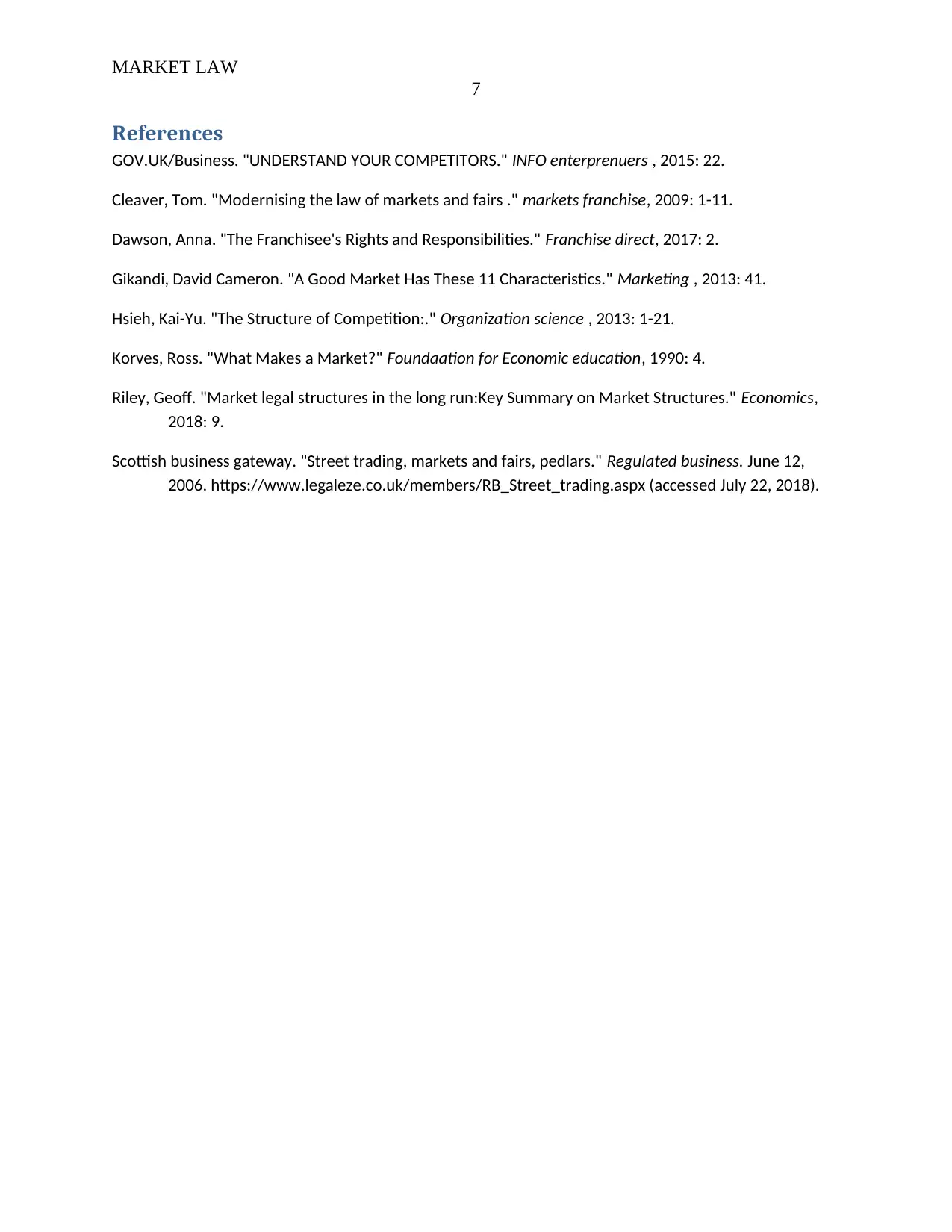
MARKET LAW
7
References
GOV.UK/Business. "UNDERSTAND YOUR COMPETITORS." INFO enterprenuers , 2015: 22.
Cleaver, Tom. "Modernising the law of markets and fairs ." markets franchise, 2009: 1-11.
Dawson, Anna. "The Franchisee's Rights and Responsibilities." Franchise direct, 2017: 2.
Gikandi, David Cameron. "A Good Market Has These 11 Characteristics." Marketing , 2013: 41.
Hsieh, Kai-Yu. "The Structure of Competition:." Organization science , 2013: 1-21.
Korves, Ross. "What Makes a Market?" Foundaation for Economic education, 1990: 4.
Riley, Geoff. "Market legal structures in the long run:Key Summary on Market Structures." Economics,
2018: 9.
Scottish business gateway. "Street trading, markets and fairs, pedlars." Regulated business. June 12,
2006. https://www.legaleze.co.uk/members/RB_Street_trading.aspx (accessed July 22, 2018).
7
References
GOV.UK/Business. "UNDERSTAND YOUR COMPETITORS." INFO enterprenuers , 2015: 22.
Cleaver, Tom. "Modernising the law of markets and fairs ." markets franchise, 2009: 1-11.
Dawson, Anna. "The Franchisee's Rights and Responsibilities." Franchise direct, 2017: 2.
Gikandi, David Cameron. "A Good Market Has These 11 Characteristics." Marketing , 2013: 41.
Hsieh, Kai-Yu. "The Structure of Competition:." Organization science , 2013: 1-21.
Korves, Ross. "What Makes a Market?" Foundaation for Economic education, 1990: 4.
Riley, Geoff. "Market legal structures in the long run:Key Summary on Market Structures." Economics,
2018: 9.
Scottish business gateway. "Street trading, markets and fairs, pedlars." Regulated business. June 12,
2006. https://www.legaleze.co.uk/members/RB_Street_trading.aspx (accessed July 22, 2018).
1 out of 7
Related Documents
Your All-in-One AI-Powered Toolkit for Academic Success.
+13062052269
info@desklib.com
Available 24*7 on WhatsApp / Email
![[object Object]](/_next/static/media/star-bottom.7253800d.svg)
Unlock your academic potential
Copyright © 2020–2025 A2Z Services. All Rights Reserved. Developed and managed by ZUCOL.





